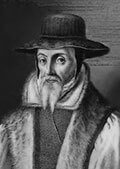the Sunday after Christmas
Click here to join the effort!
Historical Writings
A.D. (Anno Domini)
The Writings of John Foxe
Foxe's "Book of Martyrs"

John Foxe
John Foxe (1516/1517 - 18 April 1587), an English historian and martyrologist, was the author of Actes and Monuments (otherwise Foxe's Book of Martyrs), telling of Christian martyrs throughout Western history, but particularly the sufferings of English Protestants and proto-Protestants from the 14th century and in the reign of Mary I. Widely owned and read by English Puritans, the book helped to mould British opinion about the Catholic Church for several centuries.
Foxe began his Book of Martyrs in 1552, during the reign of Edward VI, with the Marian Persecutions still in the future. In 1554, while still in exile, Foxe published in Latin at Strasbourg the first shadow of his great book, emphasising the persecution of the English Lollards during the 15th century.
As word of the contemporary English persecution made its way to the continent, Foxe began to collect materials to continue his story to the present. He published the first true Latin edition of his famous book at Basel in August 1559.